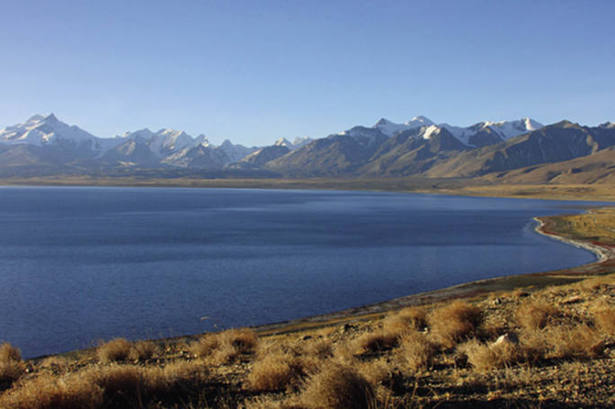Sacred Lake Baiku Co
By FAN JIUHUI
Anyone traveling between Xigaze City and Gyirong County, or between Xigaze City and Saga County via the corridor in front of Mt. Xixabangma, would en route be unable to miss Baiku Co, a large undisturbed crystal blue body of water that stands out in the drab flat terrain of a great wilderness. Sprawling over 300 square kilometers and standing at 4,590 meters above sea level, it is the largest lake in Xigaze Prefecture, in southern Tibet. Yet in Tibet as a whole it ranks low on the list of spectacular lakes, being less renowned than Nam Co, Mapam Yumco and Yamzhog Yumco.
Baiku Co is a hidden treasure whose beauty is preserved for the discerning eye of travellers to Tibet Autonomous Region. With towering Xixabangma on the horizon, its sapphire waters gleam like a lover’s teardrop on the blossoms of the Himal range, sharing its timeless solitude and serenity. Travelers who manage to make their way here are rare. Most of the time the only signs of life in this secluded region are Asiatic wild donkeys (Equus kiang) and black-necked cranes (Grus nigricollis), both rare species.
|
 |
|
Minor Baiku Co is one of the three bodies of water that constitute the sacred lake Baiku Co. |
A Sanctuary of Two Religions
Some Tibetan documents and Tibetan Buddhist texts include Baiku Co among the four sacred lakes of Tibet, the other three being Nam Co, Mapam Yumco and Yamzhog Yumco.
Seen from above, Baiku Co has the shape of a gourd, comprised of three bodies of water – Xin Co to the north, Lham Co to the southeast, and Minor Baiku Co in the southwest.
In local legends, desolate Xin Co is the haunt of female ghosts. The fact is its salty water cannot support any vegetation or aquatic life, so it is shunned by animals. Even the presence of waterfowl is rare.
Lham Co stands in stark contrast to the fertile land on its shores, dotted with barley, potato and oilseed rape fields. The lake is worshipped by residents of nearby Norbu Village, who are all followers of the ancient indigenous Bon faith. The dilapidated lamasery in the community houses the oldest and best preserved Bon murals.
Beside Minor Baiku Co sits Karmainba Village, whose residents are Tibetan Buddhists. Herding is their main source of livelihood. The shrine in the village is said to have been built by Yuthok Yonten Gonpo the Younger (1126-1201), the legendary practitioner of Tibetan medicine. Each day, locals circumambulate clockwise around the wood-structured complex to perform their Tibetan Buddhist rituals. Meanwhile, at Norbu Village across the lake, Bon devotees circle their monastery counterclockwise as decreed by tradition. For centuries people of different tribes and faiths have lived in peace by this tranquil lake.
